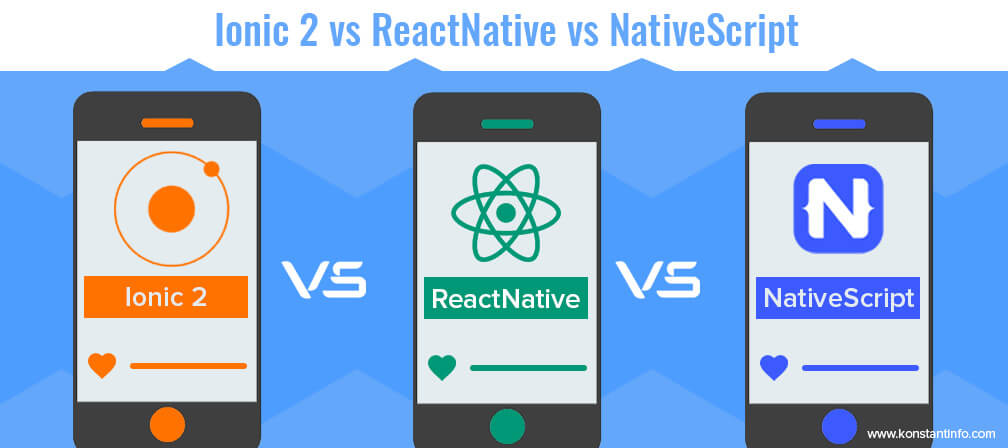
Mobile app industry is a very crowded space but with billions of potential users and new technologies entering the market is far from saturated. While there is no cookbook for making any mobile application successful, engagement and exposure are arguably two basic prerequisites that it must meet. Time-to-market is yet another important factor, which may not seem directly related, but when it comes to withstanding competition, lends a valuable edge.
Hybrid applications are the best option to meet two of those requisites- exposure and time-to-market. It doesn’t mean they do not offer fine engagement, it just means that it’s not guaranteed and depends on the tools you use to create them. So, let’s take a look at three of the most popular hybrid app development tools and see what you can expect to gain from each.
No, Ionic 2 isn’t just an incremental update to the previously popular Ionic framework but has gone through a major overhaul and packs many new features. For starters, the visual components are now based on AngularJS structure which is highly influenced by Android’s Material design and Flat design of iOS. Also, Ionic app development is TruceScript-ready, which means the existing Angular components can be readily used for the mobile app.
When it comes to creating a native experience, Ionic 2 is perhaps the most distant from the remaining two. Like its previous versions, it still relies on webviews to create the interface that is held inside a native container. To access the device hardware, it uses Apache Cordova API. Both these additional layers above the core webpage mean that the performance takes a dip, which is more visible on devices with slow processors.
Benefits
Drawbacks
Developed and largely maintained by Facebook, React Native is the rising star in the domain of hybrid app development. Unlike Ionic, it uses native components of the respective platforms to deliver the true native interface while retaining the ease of development of hybrid apps. The use of Virtual DOM enables developers to create a single codebase in JavaScript that automatically gets manipulated in the background to offer responsive design and is applicable to all platforms.
Yes, React Native helps create truly native interface but due to the additional layer of DOM between application and OS, the user experience is far from native. Plus, unlike Ionic 2, ReactNative isn’t meant to ‘write once run anywhere.’ It rather relies on a common code wrapped in a native shell. So, for each platform, React Native developers have to create the platform-specific shell that comes with its own challenges.
Benefits
Drawbacks
Developed by Telerik, NativeScript arguably offers the finest cross-platform native experience and the “write once, run anywhere,” also developers phenomenally. It uses TypeScript and AngularJS to create mobile components that offer true native interface and experience. Additionally, the use of AngularJS means that the previously created web components can be easily adapted to the mobile app and deliver a uniform experience across all platforms.
There is just one thing- NativeScript runs inside Google’s V8 engine, that though is very powerful, also makes the size of application considerably larger than their native counterparts.
Benefits
Drawbacks
Deciding about which technology to choose among a radical of available ones is in itself a task. Coming to needs you will definitely want to go with the one that is efficient in terms of time, efforts and cost. Selection of the platform will depend on the expertise you have upon working over it. All three NativeScript Vs React Native Vs Ionic are topmost Cross Platform Mobile App Development Tools which can be deployed according to resource availability and requirement. While Ionic makes use of Angular, React Native makes use of React and NativeScript brings in Angular. While Ionic is popular with Angular Developers, React Native code can be defined once and used anywhere and Native Script is apprised by users who wish to enjoy access to entire Native API, however there are many more interesting reasons to choose Ionic Vs React Native Vs NativeScript which you must select according to customized requirements. If you are still perplexed with idea of using one amongst Ionic Vs React Native Vs NativeScript, you have an option to get in touch with our experts at Konstant and get your queries fixed by a quick discussion.



Mrityunjay is a content developer at Konstant Infosolutions- a leading mobile app development firm that caters to enterprises of all scales and industries with cutting-edge tech solutions. Being an engineer by education, a reader by passion, and a writer by profession, he finds no topic truly boring, yet nothing seems to content his craving as well- an essence he leaves in everything he writes.
Or send us an email at: [email protected]